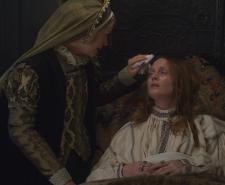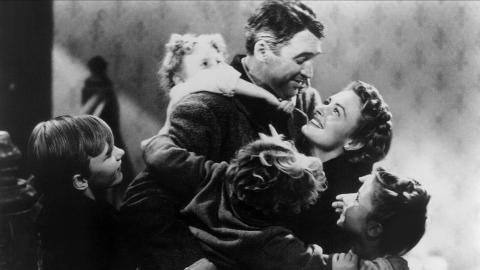
King George III's descent into madness: A tale of royal tragedy
King George III was a respected and diligent monarch who reigned for almost 60 years. However, he is, rather unfairly, mostly remembered for his descent into madness during the final years of his life.
Image: King George III in his 1762 coronation portrait by Allan Ramsey | Public Domain
The first indication that something was wrong with King George III came in the spring of 1765. The twenty-seven-year-old monarch had been on the throne for just five years when he came down with a fever, a racking cough, sudden weight loss and insomnia. Alongside these symptoms came something unexpected - a noticeable cognitive impairment that caused concern not just among the king’s courtiers, but also to the king himself, so much so that an act of parliament was passed to install a regency should George be incapacitated in such a fashion again. Thankfully, the king quickly recovered, and the act was repealed.
Violent mania
George’s second bout of illness in 1788 was far worse than the first. Whereas before George had displayed mild mental distress, this time around he was struck down with full-blown mania. Residing in Windsor Castle at the time, the king’s behaviour quickly spiralled out of control. He became extremely rude to everyone around him, he suffered from hallucinations, he started talking nonstop gibberish for hours at a time, and he began to make inappropriate advances towards women, even attempting several sexual assaults. He also suffered violent fits - the convulsions so bad that servants had to pin him to the floor to prevent him from injuring himself.
‘A raving lunatic’
George’s family and staff were mystified. This amiable, polite family man had turned into a raving lunatic. A visitor to Windsor was astonished to witness George burying a steak in the grounds of the castle, believing it would grow into a beef tree; another saw the king trying to shake hands with an oak tree, believing it to be the King of Prussia.
George’s equerry, Robert Greville, was one of many to observe the king’s bizarre behaviour up close. In his journal, Greville recalled how George spent Christmas Day 1788:
‘He had at this time his part of the bedclothes under his bed – had taken off his nightcap, and got a pillowcase round his head, and the pillow was in the bed with him which he called Prince Octavius, who he said was to be new born this day.’
Confined to Kew Palace
George was moved from his apartments at Windsor to Dutch House in the grounds of the long-since demolished Kew Palace in London. There, his physicians tried and failed to cure him of his insanity with several treatments we would now consider a form of torture. These included applying arsenic-laden powders to the king’s skin to make it burn and blister, starving him and plunging him into freezing cold water. The king was also given emetics to make him vomit and purgatives to give him diarrhoea. All these treatments were meant to ‘draw out’ the King’s madness and restore him to health. Unsurprisingly, they didn’t work.
‘Wrongheads’
Beside herself with worry, Queen Charlotte turned to Francis Willis. Willis was a provincial physician and clergyman who had come to national attention after successfully treating what were then known as ‘wrongheads’ in his own private asylum in Lincolnshire. Willis believed that the root cause of mental illness was over-excitement. He intended to cure the king by strictly controlling his behaviour.
Harsh treatments
When George ranted and raved and attacked those attending him, Willis ordered the king’s servants to gag him and place him in a straitjacket. He was left that way, thrashing around and making incomprehensible noises until he tired himself out and calmed down. When the king behaved himself, he was rewarded by being allowed to see members of his family. When he misbehaved, it was back into the straitjacket. Even mealtimes became a carrot and stick exercise. When George was bad, he ate mushed-up food with a wooden spoon; when he was good, he was allowed to use cutlery.
Recovery
The king slowly began to recover under Willis’s care, though it is debatable whether the physician’s methods contributed to his recovery. By 1789, George was completely back to normal. His recovery was a blessed relief to the prime minister, William Pitt the Younger, who feared a regency of George’s son - who favoured Pitt’s rival, Charles James Fox of the Whigs - would lead to the downfall of his government.
For his part in the king’s recovery, Willis was awarded £1,500 a year for twenty-one years. Willis returned to Lincolnshire and opened a second asylum at Shellingthorpe Hall where more patients could be treated with his - for the time - cutting-edge techniques.
Relapse
Alas, the king’s recovery was not to last. In 1801 and again in 1804 he suffered further relapses and was again confined to Dutch House. He recovered from both relapses, but it was clear that the king’s mental and physical health was deteriorating.
The final blow came in 1810. Already almost totally blind due to cataracts, the king suffered a final catastrophic mental breakdown that left him permanently insane. For the last ten years of his reign, he cut a sad and lonely figure - wandering the corridors of Windsor Castle, a ghostly figure dressed in soiled clothes with a long flowing beard. When his beloved wife Charlotte died in 1818, George had no idea who she was and did not mourn her.
Death
King George III died on the 29th of January 1820 at the age of eighty-one. He had reigned for sixty years and remains to this day the longest-serving male monarch in British history. Only his niece Victoria and his descendant Elizabeth II would go on to reign for longer.
What was wrong with King George III?
King George III reigned for almost 60 years, the third longest in British history. He was not only a respected and diligent monarch but one immensely popular amongst the general populace, as well as in the political establishment.
However, rather unfairly, he’s now mostly remembered as the king who lost America and went mad. Interest in his madness has led to fictional depictions on both stage and screen, mostly famously Alan Bennett's long-running play The Madness of King George.
What exactly caused George's illness has been up for both scientific and historical debate for centuries. We look at the leading theories behind his madness to see whether any of them contain some truth.
An imbalance of humours
The first signs that George was suffering from something came during his mid-twenties when he began behaving strangely after a bout of fever. He quickly recovered and all was forgotten. However, his next relapse, which didn't occur until he was 50 years old in 1788, saw the king descend into what has been described as 'full-blown mania'.
The affable, likeable, and polite monarch turned into an increasingly irrational person who constantly suffered hallucinations and violent fits. The belief amongst his physicians was that George was suffering from an imbalance of the four humours. This system of medicine argued that the human body was made up of four vital fluids - blood, phlegm, yellow bile, and black bile. A harmonious balance between them all equalled a healthy body, whilst an imbalance caused illness.
Given the primitive understanding of mental health during the 18th century, George was subjected to torturous methods of treatment in the hope of 'drawing out' his madness and restoring balance to his four humours.
Of course, none of the treatment worked but the king did eventually recover by the following year. However, it was not to last and further relapses over the subsequent years saw George’s mental and physical health deteriorate further until he was declared permanently insane.
For the final 10 years of his reign, his son, the future George IV, was officially declared Prince Regent and ruled as a de facto leader.
Porphyria
During the 19th century, the germ theory of disease became accepted as the scientific reason behind many diseases. The idea of the four humours had been disproved and so George’s illness was once again up for debate.
During the mid-1960s, Dr Ida Macalpine and Dr Richard Hunter proposed a new theory about George’s madness. The American mother and son duo were both psychiatrists and had spent hours poring over George’s extensive medical records.
They concluded he must have suffered from porphyria, a rare genetic disorder that affects the body's ability to make haemoglobin. Several symptoms of the disease seemed to match those that George suffered, including insomnia, stomach pains, hallucinations, and discoloured urine.
The theory caught on and was soon widely accepted as the medical reason behind George’s ailments. A 2005 analysis of George’s hair discovered high levels of arsenic which may have triggered the onset of porphyria.
Bipolar disorder
More recently, researchers at St George's, University of London, have countered the porphyria argument and instead suggested George suffered from the mental health condition known as bipolar disorder.
After reviewing thousands of George III's own handwritten letters, the research team saw a pattern. When the king was unwell his sentences were much longer, he repeated himself and used more complex language. Such symptoms are seen by those experiencing the ‘manic phase’ of bipolar disorder. Contemporary accounts also confirm the overactive, euphoric moods that George was prone to, again supporting the bipolar theory.
As for the discoloured urine, the researchers believe it was caused by a medication George was prescribed called gentian violet, which is known to turn urine into a bluey/purple colour.
In his final years, George developed dementia. This, combined with severe bipolar disorder, would explain his permanent insanity.
Whilst the bipolar disorder argument has gained much traction in recent years, we may never be able to say for sure what exactly caused George’s madness.
The legacy of a popular king
Whatever was at the root of George’s madness, he was in his lifetime a very popular king. Far from the mad monarch and tyrant of the American imagination, George was a wise, fair and popular monarch whose support for and promotion of Britain and the arts and sciences during his reign made him amongst the most enlightened and forward-thinking kings in Europe. That he was stricken with an illness that today could have been treated with medicine and cognitive behavioural therapy is a tragic consequence of his living during a less knowledgeable and more uncaring age.
Facts About George III
- George was the first of the Hanovarian kings to be born in England and speak English as his first language.
- The enclosed, eight-horse-drawn carriage called the Gold State Coach that took Elizabeth II to her coronation at Westminster Abbey in 1953 was commissioned by George III in 1760. It cost £7,562 at the time - the equivalent of £3.5 million today.
- George III bought Buckingham Palace - then known as Buckingham House - for his wife Charlotte to use as a family home in 1761. It would not become the official London residence of the British monarch until George’s niece Victoria ascended the throne in 1837.
- George was very interested in agriculture and often made notes in the many agricultural books he read over the years. His interest in plants earned him the affectionate nickname ‘Farmer George’.
- Following his descent into madness in 1810, George’s son, the future King George IV, became Prince Regent. The Regency era became known for its fashion, culture and architecture. In reality, the Regency benefitted a tiny handful of the wealthiest in society. For most people, the Regency was a period of extreme poverty and mass unemployment.


























